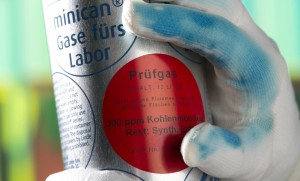Gloves that change colour as a signal you’re handling toxic substances have been developed by a research team at the Fraunhofer Institute according to a May 2, 2013 Fraunhofer Research Institution for Modular Solid State Technologies EMFT news release (also on EurekAlert as a re-issued June 7, 2013 news release),
Employees in chemical production, the semiconductor industry or in laboratories are frequently exposed to harmful substances. The problem: Many of these aggressive substances are imperceptible to human senses, which makes handling them so risky. That’s why there is a broad range of solutions that employers can use to protect their staff from hazardous substances – from highly sensitive measuring equipment to heat imaging cameras. Soon, this spectrum will be enhanced by one more clever solution that is easy to handle, and that dispenses with a power supply. Researchers at the Fraunhofer Research Institution for Modular Solid State Technologies EMFT in Regensburg have engineered a glove that recognizes if toxic substances are present in the surrounding air.
Here’s an image of the glove,
The news release provides more details,
The protective glove is equipped with custom-made sensor materials and indicates the presence of toxic substances by changing colors. In this regard, the scientists adapted the materials to the corresponding analytes, and thus, the application. The color change – from colorless (no toxic substance) to blue (toxic substance detected), for example – warns the employee immediately. …
….
The warning signal is triggered by an indicator dye integrated into the glove that reacts to the presence of analytes, in this case, the toxic substances. The experts at EMFT used a variety of techniques in order to furnish textiles with sensor-activated dyes. The sensor-activated dyes are applied to the clothing with the customary dye and print process, for example, by affixing them in an immersion bath. Previously, the researchers used targeted chemical modification to adapt the color molecules to the fiber properties of the respective textile. Alternatively, the textiles can also be coated with sensor particles that are furnished with sensor dyes. For this purpose, the scientists integrated the dye molecules either into commercial pigments or they built them up on an entirely synthetic basis. The pigments are then manufactured according to the customary textile finishing process, for instance, the sensor particles are also suitable for silkscreening. “Which version we opt for depends on the requirements of the planned application,” says Trupp [Dr. Sabine Trupp, head of the Fraunhofer EMFT Sensor Materials group].
The challenge lies foremost in the tailored development of sensor dyes. “The dye molecule must detect a specific analyte in a targeted manner – only then will a chemical reaction occur. Moreover, the dye must adhere securely; it cannot disappear due to washing. We aim for the customer’s preferences in the color selection as well. All of these aspects must be kept in mind when developing the molecule and pigment properties,” explains Trupp.
The technology could be extended to do more and could be adapted for other applications (from the news release),
The expert already has new ideas about how the solution could be developed further. For example, a miniaturized sensor module, integrated into textiles, could record toxic substances, store the measurement data and even transmit them to a main unit. This way, you could document how frequently an individual within a hazardous environment was exposed to poisonous concentrations over a longer period of time.
The researchers also envision other potential applications in the foodstuffs industry: In the future, color indicator systems integrated into foils or bottle closures are intended to make the quality status of the packaged foods visible. Because the sell-by date does not represent a guarantee of any kind. Foodstuffs may often spoil prematurely – unnoticed by the consumer – due to a packaging error, or in the warehousing, or due to disruptions in the refrigeration chain. Oil-based and fat-containing products are specifically prone to this, as are meats, fish and ready meals.
The notion that food packaging could be designed to include sensors that alert consumers and retailers about product spoilage is not new and was mentioned recently and briefly in my Mar. 25, 2013 posting which featured excerpts from an interview with biotechnologist Christoph Meili about nanotechnology-enabled food packaging.

Pingback: Gloves, Québec’s (Canada) Institut de recherche Robert-Sauvé en santé et en sécurité du travail, and a workplace nanotoxicity exposure report « FrogHeart